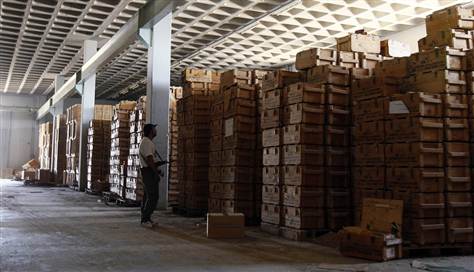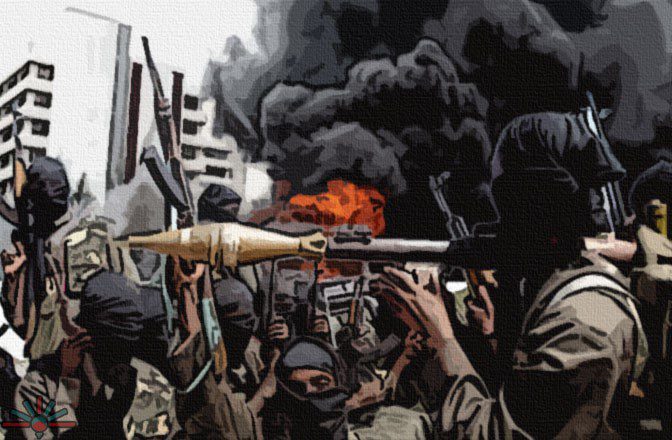Over two years after NATO’s 2011 intervention in the Libyan Civil War, the effects of Operation Unified Protector are still being felt across the region. In what has been touted as one of the most successful interventions in recent history, which saw the quick removal of Muammar Gaddafi and the prevention of mass atrocities committed against the civilian population, a variable that was largely overlooked was the release of thousands of weapons from abandoned weapons caches that have destabilized the entire region.
Due to the nature of the intervention, which saw a massive use of air power to enforce a no-fly zone over Libyan territory and a minimal use of ground personnel, much of what took place on the ground was left largely to the Libyan rebel forces and out of the control of NATO. While this did ensure that NATO did not experience any major losses in the war and prevented Western countries from becoming tied down in a ground occupation, it allowed the weapons arsenals of Muammar Gaddafi to be freely looted by anyone who came upon them as loyalist forces retreated to Tripoli.
Over the course of his reign, Muammar Gaddafi accumulated one of the largest stockpiles of weapons in Africa. For much of the period in which he was in power, Libya faced a number of arms embargoes that blocked large scale accumulation of advanced weapons, but after a 2003 Security Council resolution that lifted many of those restrictions, Libya conducted a number of arms deals with Western countries that included advanced assault rifles, heavy weapons and communication systems. Massive weapons caches strategically-placed across the country fell under the control of the rebels one after another as the war progressed. Similar to the way in which weapons depots were left exposed and unattended following the Soviet Union’s collapse, in many cases loyalist forces simply abandoned weapon caches as they retreated.
[captionpix align=”left” theme=”elegant” width=”300″ imgsrc=”http://natoassociation.ca/wp-content/uploads/2013/06/LibyaWeaponsSpreadout.jpg ” captiontext= “Small arms looted in Libya.”]
While NATO did go out of its way to destroy any surface to air weapon installations it could locate during the campaign in order to protect its air assets, all other weapon depots were left untouched, with the hope that the rebels would use them to supply themselves. As a result, these huge stockpiles of weapons, which included mortars, rocket propelled grenades, and missiles, were left for the taking by anyone, rebel or not, who came across them. Finally, and of greatest concern, numerous Soviet and Western made surface to air missile launchers were housed in the now looted weapons caches. In the past these weapons, of which an estimated 20,000 were in Libya at the time of the civil war, have been used by terrorist groups to attack passenger planes in Baghdad and Kenya.
North African Proliferation
Since 2011, it has been speculated that Libyan weapons have acted as catalysts for the renewed outbreaks of violence in Mali and Nigeria, as well as a resource for militants in Syria, Egypt and the Gaza Strip. A report from this year by the UN Security Council’s Group of Experts stated that “illicit flows from [Libya] are fuelling existing conflicts in Africa and the Levant and enriching the arsenals of a range of non-State actors, including terrorist groups”. In the case of Mali, it was not just Libyan weapons that drastically increased the capabilities of the Al Qaeda-allied Tuareg rebels, but Libyan personnel as well. After the fall of Gadaffi, thousands of Tuareg mercenaries trained and hired by the ex-Libyan government streamed back into Mali, bringing with them weapons and expertise that the Malian military was totally unprepared for.
The same difficult situation has arisen in Nigeria, in which government forces have been confronted with advanced anti-tank and anti-aircraft weapons by insurgents that had previously been fighting with much less sophisticated weaponry. Boko Haram has made such gains in recent months that the government of Nigeria was recently forced to declare a state of emergency in its north eastern states. Thus in both the Nigerian and Malian cases, this upsurge of violence can be attributed directly to the new acquisition of weapons. Rebel groups in both countries have become emboldened by their newfound strength.
Finally, militants in ongoing conflicts in Syria and Gaza have been reported to have been using Libyan weapons, becoming armed with anti-aircraft missiles that have shifted the balance of power in both regions.
The much publicized French intervention in Mali that took place in order to roll back advances made by the rebels was a telling and expensive consequence of Libyan weapon proliferation, and revealing of the potential future costs to NATO countries should it continue. In a region as fractured and volatile as North Africa, the Malian case has proven that access to more advanced weapons is all it takes to drastically alter the balance of power in favour of insurgent groups. Now that Libyan weapons are spreading across the continent, this issue cannot be ignored. Groups in countries such as Somalia, Egypt, Congo and Sudan can all benefit greatly from the weapons used in Mali and Nigeria, which would engulf even more countries into a newfound upsurge of violence.
Solving the Problem
The most serious obstacle that will confront policy makers in solving the problem of the spread of Libyan weapons is the state of contemporary Libya itself. The new post-war government is very fragile and exerts only a limited degree of control over the country, competing with heavily armed militias and tribal groups. These militias, formed during the war, still roam around the country and possess much of the weaponry in question. This situation had rendered the new government incapable of adequately guarding and overseeing the weapon depots that remain, not to mention disarming the population and policing the country’s borders. Until the Libyan government gains full control of its territory and population, the burden will fall on neighbouring countries, as well as Western governments, to stop the flow of weapons into the hands of insurgents. NATO should continue to assist government agencies that monitor and curb illicit weapon proliferation, while it should also play a role in establishing a strong enforcement agency within Libya. While that is being accomplished, states bordering Libya and other transit areas for these weapons should increase their coordination and communication with each other in order to halt the flow of weapons into their country.




